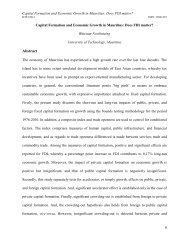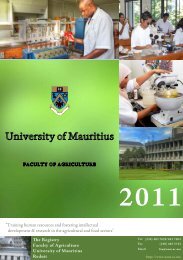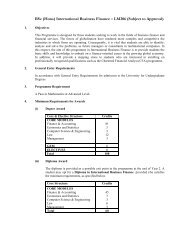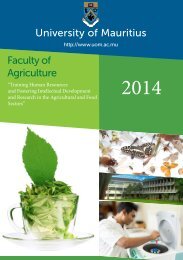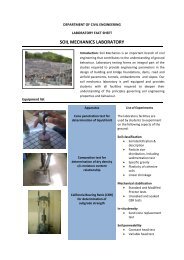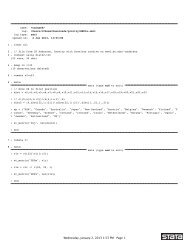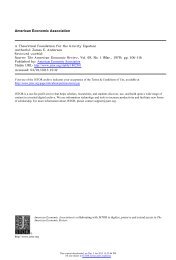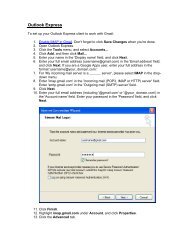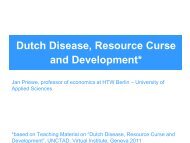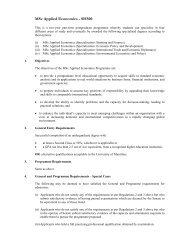SACU Revenue Sharing Formula - the University of Mauritius
SACU Revenue Sharing Formula - the University of Mauritius
SACU Revenue Sharing Formula - the University of Mauritius
You also want an ePaper? Increase the reach of your titles
YUMPU automatically turns print PDFs into web optimized ePapers that Google loves.
ICITI 2012 ISSN: 16941225c) The End <strong>of</strong> Apar<strong>the</strong>id – 1994-2002 <strong>SACU</strong> RenegotiationsThe renegotiation <strong>of</strong> <strong>SACU</strong> Agreement in 1994-2002 was not simply about a revenueformula. It was a renegotiation between sovereign states and <strong>the</strong> entire foundation was to bepredicated on de jure equality between <strong>the</strong> contracting parties. Many <strong>of</strong> <strong>the</strong> new provisions <strong>of</strong> <strong>the</strong><strong>SACU</strong> 2002 agreement were about <strong>the</strong> establishment <strong>of</strong> tariffs and excise as well as <strong>the</strong>operating modalities <strong>of</strong> <strong>the</strong> new <strong>SACU</strong>. Tariffs and excise were no longer to be <strong>the</strong> sole purview<strong>of</strong> South Africa and in <strong>the</strong>ory at least all members were to have a say. This is an importantcontrast to <strong>the</strong> 1969 agreement where <strong>the</strong>re was no pretense <strong>of</strong> equality between <strong>the</strong> membersand all decisions regarding tariffs and excise remained <strong>the</strong> prerogative <strong>of</strong> South Africa. Thesechanges were emblematic <strong>of</strong> <strong>the</strong> end <strong>of</strong> <strong>the</strong> apar<strong>the</strong>id era and were concessions <strong>of</strong> greatimportance to <strong>the</strong> BLNS. However, <strong>the</strong> fundamental reality on <strong>the</strong> ground <strong>of</strong> a membership withvastly differing technical capacities to deal with trade policy issues cannot be changed by treatyalone.When it came to <strong>the</strong> RSF <strong>the</strong> negotiated 2002 RSF eliminated <strong>the</strong> down-side risk to <strong>the</strong>South African treasury that it could end up eventually paying <strong>the</strong> BLNS more than <strong>the</strong> value <strong>of</strong><strong>the</strong> common revenue pool but in <strong>the</strong> process fur<strong>the</strong>r increased <strong>the</strong> share accruing to <strong>the</strong> BLNS at<strong>the</strong> expense <strong>of</strong> South Africa (Kirk and Stern 2005). Whe<strong>the</strong>r in retrospect Pretoria‟s concern that<strong>the</strong> 1969 formula would ever have exhaust <strong>the</strong> <strong>SACU</strong> revenue pool is ano<strong>the</strong>r matter. Devisingan agreed formula which would simultaneously eliminate <strong>the</strong> down-side risk for Pretoria withoutundermining <strong>the</strong> BLNS revenue explains in part why <strong>the</strong> 1994 negotiations were so protracted.The new RSF was based on three separate components 27 . The first component <strong>of</strong> <strong>the</strong> newformula was a division <strong>of</strong> customs revenue on a new basis which made no reference whatsoeverto imports from outside <strong>the</strong> customs union. The share <strong>of</strong> each member was to be based on <strong>the</strong>share <strong>of</strong> intra-<strong>SACU</strong> imports. Thus <strong>the</strong> formula had gone full circle from 1910 and now, ra<strong>the</strong>rthan being dependent upon imports from outside <strong>the</strong> customs union, <strong>the</strong> share was based only oninternal trade. Due to <strong>the</strong> economic polarization which occurs within <strong>the</strong> <strong>SACU</strong> customs unions<strong>the</strong> structure <strong>of</strong> trade that had emerged between <strong>the</strong> BLNS and South Africa over <strong>the</strong> years hasmeant that <strong>the</strong> vast bulk <strong>of</strong> <strong>the</strong> customs pool would go <strong>the</strong> BLNS but at least South Africa wouldobtain a portion <strong>of</strong> those revenues by entitlement ra<strong>the</strong>r than as a residual under <strong>the</strong> 1969formula. Thus <strong>the</strong> RSF based on intra-<strong>SACU</strong> imports should be seen as a way <strong>of</strong> compensatingfor structural polarization.The second component was <strong>the</strong> excise revenue. This was divided into two halves, <strong>the</strong> firstbeing 85% <strong>of</strong> <strong>the</strong> total excise revenue which was disbursed purely by <strong>the</strong> share <strong>of</strong> <strong>the</strong> GDP <strong>of</strong>each <strong>of</strong> <strong>the</strong> <strong>SACU</strong> members. The second component, <strong>the</strong> remaining 15%, was a developmentcomponent which was instigated at South Africa‟s behest. This portion <strong>of</strong> <strong>the</strong> revenue would bedistributed in inverse proportion to <strong>the</strong> GDP per capita <strong>of</strong> each member. Thus <strong>the</strong> poorestmembers <strong>of</strong> <strong>SACU</strong> would receive a disproportionate share <strong>of</strong> this element <strong>of</strong> <strong>the</strong> excise. As aresult, this particular share would end up being distributed in roughly equal portions to allmembers. The development component was <strong>the</strong>refore in essence an equalization fund. While itwas an equalization fund it became general revenue for all <strong>SACU</strong> members and <strong>the</strong>re was noassurance that <strong>the</strong> resources would be used for development projects by members 28 .8




